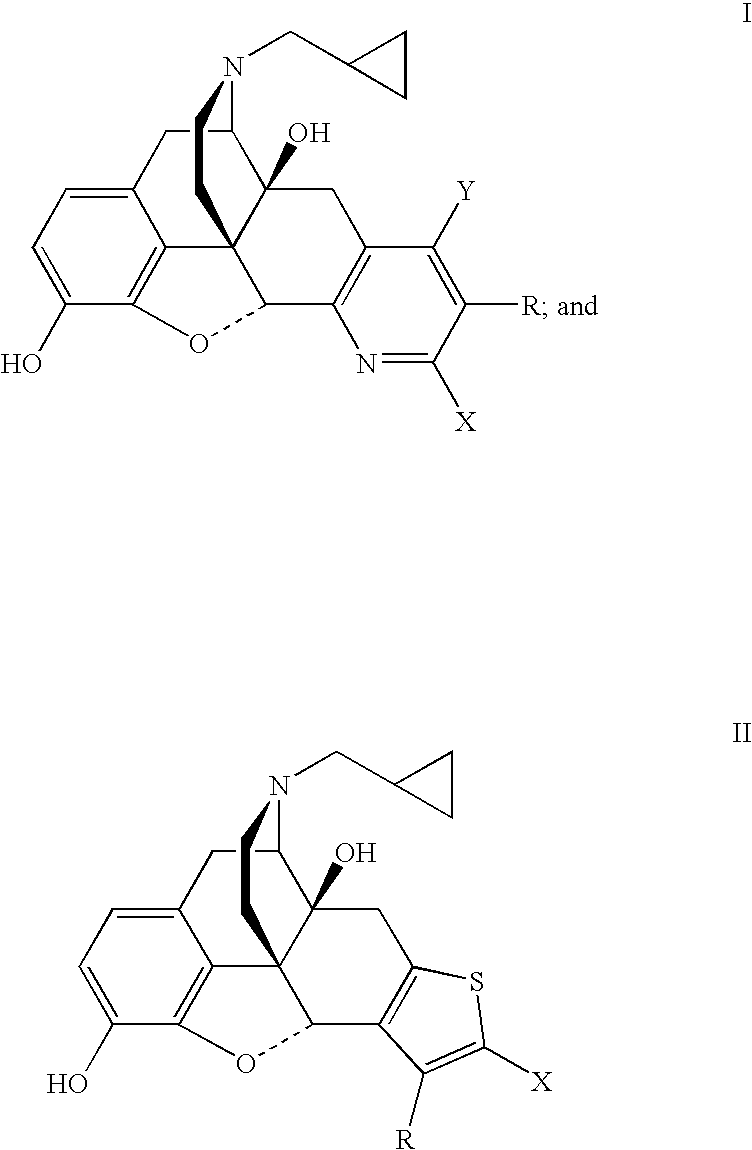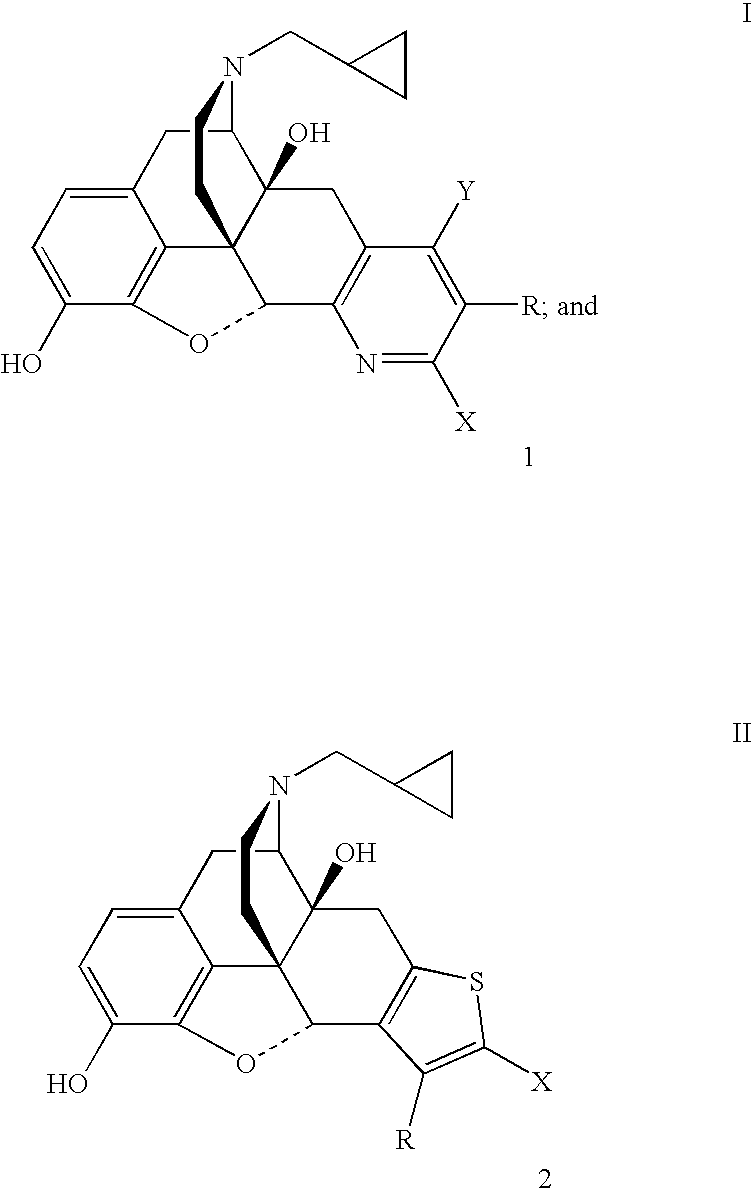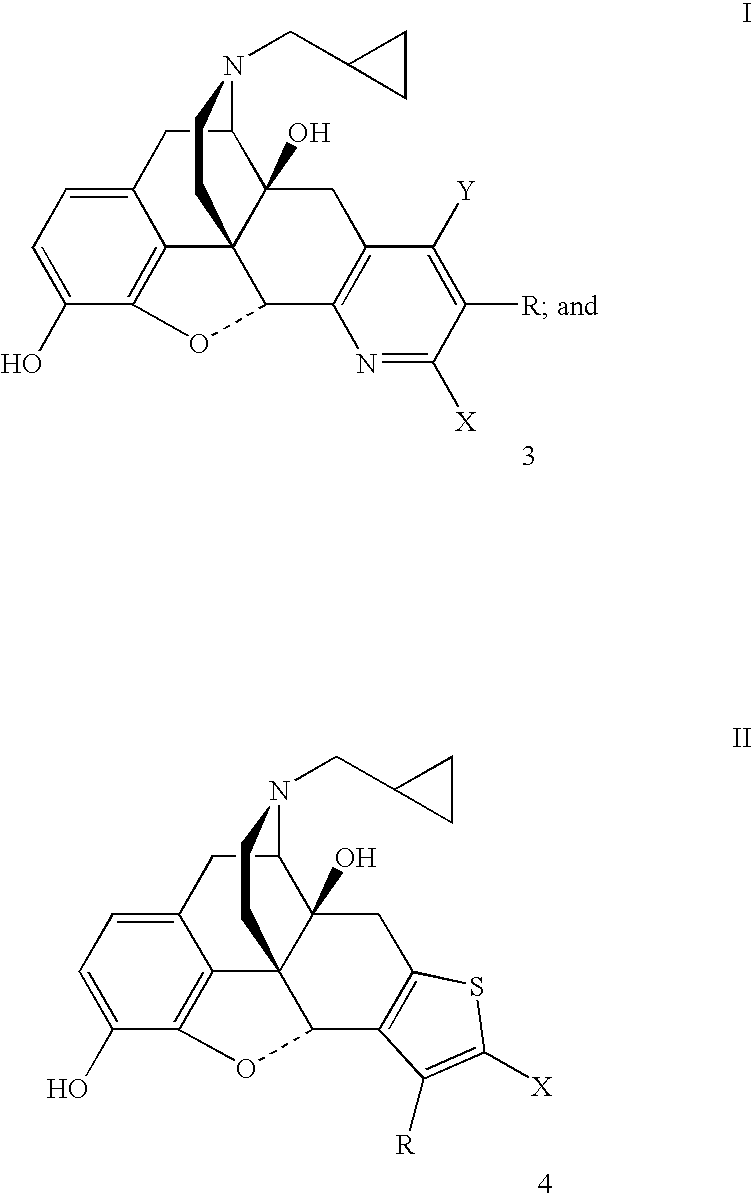Pyridomorphinans, thienomorphinans and use thereof
a technology of thienomorphinan and pyridomorphinan, which is applied in the field of pyridomorphinan and thienomorphinan compounds, can solve the problems of limited general administration of these medications, and achieve the effect of modulating toleran
- Summary
- Abstract
- Description
- Claims
- Application Information
AI Technical Summary
Benefits of technology
Problems solved by technology
Method used
Image
Examples
example 1
Preparation of 5′-Bromo-17-(cyclopropylmethyl)-6,7-didehydro-3,14-dihydroxy-4,5α-epoxypyrido[2′,3′:6,7]morphinan (7b).
[0038]A mixture of naltrexone (1.0 g, 2.9 mmol), 2-bromo-3-(dimethylamino)acrolein (1.04 g, 5.9 mmol) and ammonium acetate (0.92 g, 12.0 mmol) in glacial acetic acid (15 mL) was heated under reflux under an atmosphere of argon for 3 days. The acetic acid was removed under reduced pressure and the residue was treated with water and the mixture was made basic with concentrated aqueous NH4OH. The mixture was extracted with CH2Cl2 (3×80 mL). The combined organic extracts were washed with brine, dried (Na2SO4) and the solvent was removed under reduced pressure. The residue was purified by flash chromatography over a column of silica using CHCl3-MeOH (99.5:0.5) followed by CHCl3—MeOH—NH4OH (99:0.5:0.5) as the eluent to obtain 7b (0.212 g): mp 266–268° C. dec; TLC, Rf0.43 (CHCl3—MeOH—NH4OH, 95:5:0.5).
example 2
Preparation of 5′-Cyano-17-(cyclopropylmethyl)-6,7-didehydro-3,14-dihydroxy-4,5α-epoxypyrido[2′,3′:6,7]morphinan (7c).
[0039]A mixture of naltrexone (1.0 g, 2.9 mmol), 2-cyano-3-(dimethylamino)acrolein (0.73 g, 5.9 mmol) and ammonium acetate (0.92 g, 12.0 mmol) in glacial acetic acid (15 mL) was heated under reflux under an atmosphere of argon for 3 days. The acetic acid was removed under reduced pressure and the residue was treated with water and the pH of the mixture was adjusted to 8 with concentrated aqueous NH4OH. The mixture was extracted with CH2Cl2 (3×80 mL). The combined organic extracts were washed with brine, dried (Na2SO4) and the solvent was removed under reduced pressure. The residue was purified by flash chromatography over a column of silica using CHCl3—MeOH—NH4OH (98.5:1.0:0.5) as the eluent to obtain 7c (0.142 g): mp 152–158° C. dec; TLC, Rf 0.21 (CHCl3—MeOH—NH4OH, 95:5:0.5).
example 3
Preparation of 5′-Carbethoxy-17-(cyclopropylmethyl)-6,7-didehydro-3,14-dihydroxy-4,5α-epoxypyrido[2′,3′:6,7]morphinan (7d).
[0040]A mixture of naltrexone (1.0 g, 2.9 mmol), 2-carbethoxy-3-(dimethylamino)acrolein (1.0 g, 5.9 mmol) and ammonium acetate (0.92 g, 12.0 mmol) in glacial acetic acid (15 mL) was heated under reflux under an atmosphere of argon for 30 h. The acetic acid was removed under reduced pressure and the residue was treated with water and the pH of the mixture was adjusted to 8 to 9 with saturated aqueous NaHCO3. The mixture was extracted with CH2Cl2 (4×150 mL). The combined organic extracts were washed with brine, dried (Na2SO4) and the solvent was removed under reduced pressure. The residue was purified by flash chromatography over a column of silica using CHCL3—EtOH—NH4OH (98.5:1.0:0.5) as the eluent to obtain 7d (0.503 g): mp 138–145° C. dec; TLC, Rf0.29 (CHCl3—MeOH—NH4OH, 95:5:0.5).
PUM
 Login to View More
Login to View More Abstract
Description
Claims
Application Information
 Login to View More
Login to View More - R&D
- Intellectual Property
- Life Sciences
- Materials
- Tech Scout
- Unparalleled Data Quality
- Higher Quality Content
- 60% Fewer Hallucinations
Browse by: Latest US Patents, China's latest patents, Technical Efficacy Thesaurus, Application Domain, Technology Topic, Popular Technical Reports.
© 2025 PatSnap. All rights reserved.Legal|Privacy policy|Modern Slavery Act Transparency Statement|Sitemap|About US| Contact US: help@patsnap.com



